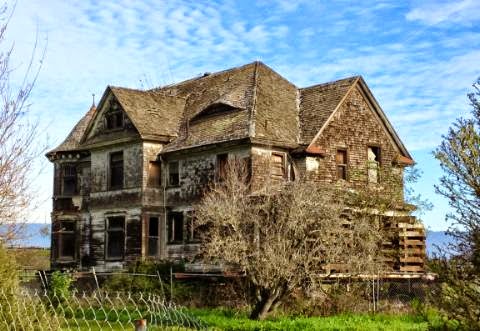When is a "Fixer-Upper" Home Beyond Fixing Up?
Here is a very large farm house in Watsonville California which is located between Salinas & Santa Cruz.
When I first saw this old home 4-5 years ago, I stopped by with amazement on just how large this home is.
Well I drove by the home again a week ago and just had to stop to take some photos.
The home is condemned and is connected to large farming acreage with barns and other buildings on the property.
By looking at the fence and signs around the home, it looks like either this home is going to become a Historical Landmark, or that it's going to possibly be fixed up.
By looking at the age of this home, I am going to say it's beyond fixing up.
But latest breaking news on this fixer-upper ...
But latest breaking news on this fixer-upper ...
I just found a link connecting to this old home called the Redman House while writing this post ;o)
Redman House photograph taken by Robert Swetz 2015
The Internet sure can be amazing sometimes with the information we can find.
| The Redman-Hirahara House is a prime example of a West Coast Victorian farm estate home situated on almost 14 acres of farmland clearly visible from Scenic Highway 1 in the Pajaro Valley on California's Central Coast. She greets the Pajaro Valley's visitors and passersby like a grand lady fallen on hard times, just a faint relic of the noble and gracious beauty that commanded the views of the river and valley from her overlook on West Beach Road. Her former elegance has been lost to time and the elements. The once magnificent two-story Queen Anne Victorian home stands out as a symbol of history in the middle of a farm field. The house was built for James Redman in 1897; designed by renowned architect William H. Weeks. The building contract was let to the local firm of Lamborn and Uren, at a negotiated cost of $3,368. The interior of the home was finished in eastern oak, birds eye maple and natural hardwoods. In the early years it was lighted by acetylene gas and it was said contained all the conveniences for modern housekeeping. When the James Redman family died out in the 1930s, the house and property were sold to the Hirahara family, one of the first Japanese-American families to own farmland in the nation. Home to this honorable and distinguished Japanese family, the house continued in her role as a farming headquarters. After the bombing of Pearl Harbor, the Hirahara family, along with the other Japanese families in the valley and across the state, were removed from the area and delivered to internment camps. The Hirahara family managed to maintain ownership of the house and their lands, with the often-anonymous assistance from the local community of Watsonville. After the war they returned home and it was during this period that the house and converted barn became an interim home for several other Japanese families while they reestablished themselves in the community. Prior to the 1989 Loma Prieta earthquake that ripped through the Pajaro Valley, the Redman House was occupied by the Hiraharas, but the house and lands had been sold to Green Farm, a partnership of investors. The land was leased for commercial strawberry farming and the house left to deteriorate. There were plans at that time of developing the land and making it a profitable venture, contrary to local public sentiments. In late 1998, a group of Pajaro Valley residents formally formed The Redman House Committee to determine what could be done to save the once beautiful and elegant, now neglected and vacant, 100-year old Victorian house and to develop a new public use for it. From these meetings, the Committee added The Redman House to the National Registry of Historic Places to prohibit demolition, leased the now fallow land and abandoned farmstead, and designed a conceptual master plan to transform this site into a landmark Visitor and Cultural Education center. These activities brought about the transition of the Redman House Committee to the Redman-Hirahara Foundation in 2001. In November of 2004, the Redman-Hirahara Foundation was granted 501(c)3 non-profit status as a public charity for educational purposes. In February of 2005, the property was purchased by The Redman-Hirahara Foundation with borrowed funds for $1.9 million. The surrounding 10 acres of farmland now produces colorful organic crops year-round. Property acquisition discussions with non-profit land trust organizations to reduce the debt service of The Redman-Hirahara Foundation are in progress. Facing the challenges of financial strength and the ongoing deterioration of the house, the Redman-Hirahara Foundation Board of Directors are focused and determined to obtain individual, corporate, and government funding in order to accomplish their vision. The steadfast mission of the Redman-Hirahara Foundation Board of Directors is restoring and preserving the Redman-Hirahara property for the historic and cultural education and enrichment of the residents and visitors of the Central Coast of California. With the help of generous people like you, we can restore this wonderful house back to its original grandeur and develop a landmark community-based educational facility. |
Redman-Hirahara Foundation
PO Box 2526
Watsonville, CA 95077-2526
PO Box 2526
Watsonville, CA 95077-2526
Copyright © Redman-Hirahara Foundation, All Rights Reserved. Pacific Web Effects





No comments:
Post a Comment